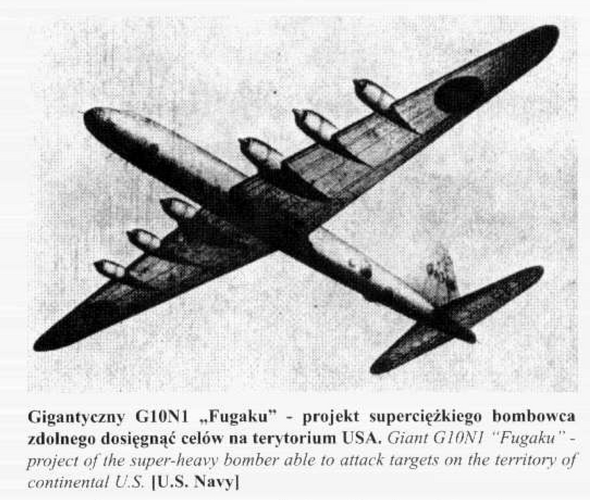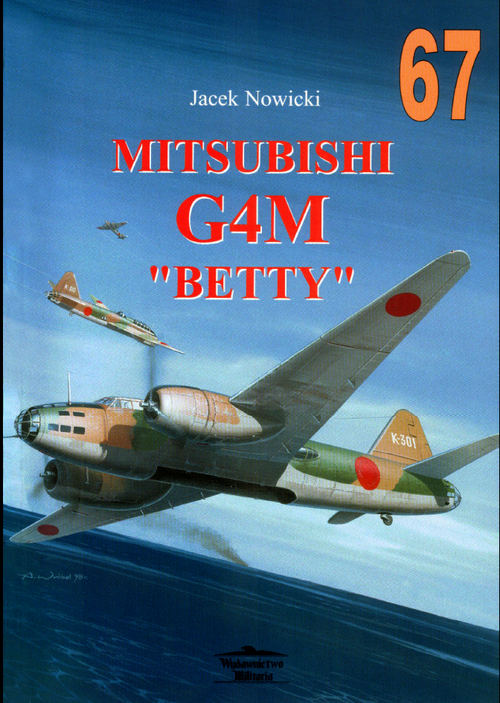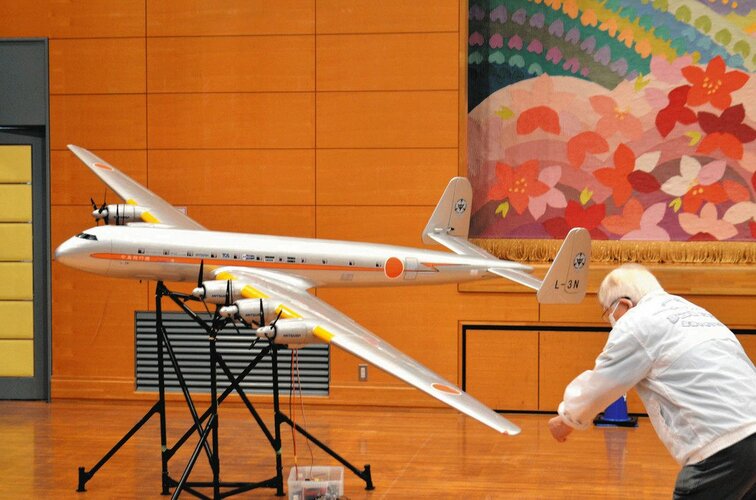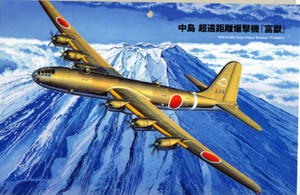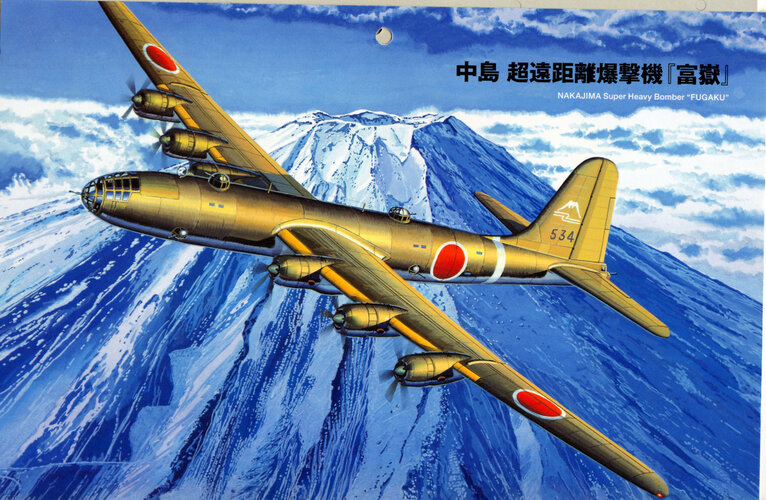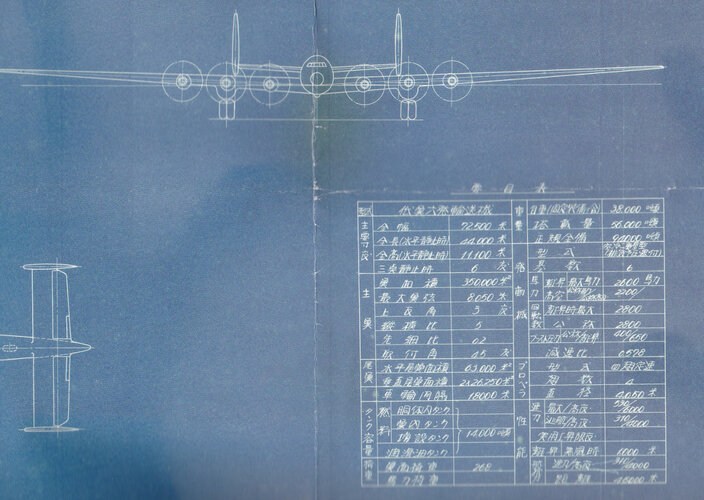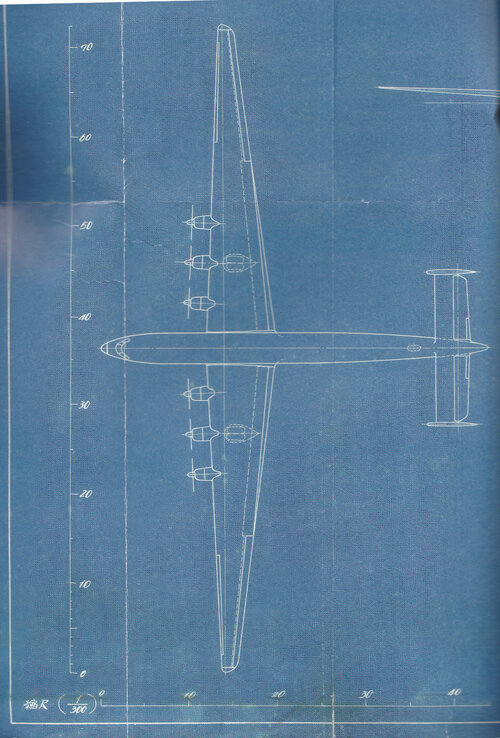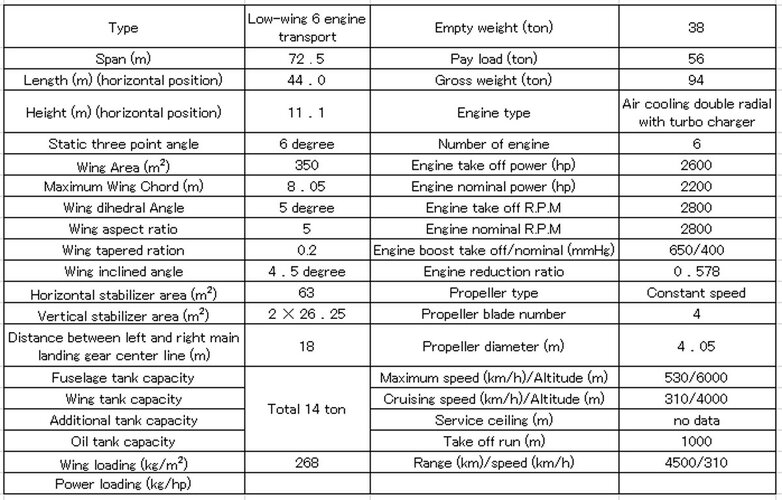You are using an out of date browser. It may not display this or other websites correctly.
You should upgrade or use an alternative browser.
You should upgrade or use an alternative browser.
Fugaku : Z-plane, G10 or G12
- Thread starter Antonio
- Start date
blackkite
Don't laugh, don't cry, don't even curse, but.....
- Joined
- 31 May 2007
- Messages
- 8,299
- Reaction score
- 5,916
Chikuhei Nakajima, the founder of Nakajima Aircraft, predicted that Japan would be burned by the bombing of the US military , and thought that the only way to win the war was to bomb the continental United States.
Therefore, Nakajima Aircraft planned the Z plane, which is a bomber capable of bombing the continental United States alone.
The plane carried a 10-ton bomb, had a cruising range of 18,000 km, and required six 5000-horsepower engines.
The plan was to launch the bomber from a base on the Kuril Islands, cross the Pacific Ocean in a jet stream, bomb Pittsburgh and New York, then cross the Atlantic Ocean, and land in Germany-occupied France.
The return trip was planned to bomb the Soviet Union in some cases and return to Japan.
The plan for this bomber was compiled into a plan called a “Winning game plan” and proposed to the Japanese government and the Japanese military.
This proposal was adopted, the bomber was named Fugaku and the Fugaku Committee was formed by the military, Nakajima Aircraft and others.
As for the 5000 horsepower engine, Nakajima tried to develop the Ha 54 engine by combining two 2500 horsepower Nakajima Ha44 double air-cooled radial engines in series.
However, as the design progressed, it turned out to be difficult to cool the last row of quadruple engines, and this solution was expected to take a considerable amount of time.
Therefore, the Fugaku Committee decided to develop a bomber using six Ha44 engines and a bomber using six 3000 horsepower Ha50 engines, which was under development by Mitsubishi, as an emergency measure.
After that, the battlefield deteriorated, mass production of fighters became necessary, and the plan for the Fugaku bomber was canceled.
Therefore, Nakajima Aircraft planned the Z plane, which is a bomber capable of bombing the continental United States alone.
The plane carried a 10-ton bomb, had a cruising range of 18,000 km, and required six 5000-horsepower engines.
The plan was to launch the bomber from a base on the Kuril Islands, cross the Pacific Ocean in a jet stream, bomb Pittsburgh and New York, then cross the Atlantic Ocean, and land in Germany-occupied France.
The return trip was planned to bomb the Soviet Union in some cases and return to Japan.
The plan for this bomber was compiled into a plan called a “Winning game plan” and proposed to the Japanese government and the Japanese military.
This proposal was adopted, the bomber was named Fugaku and the Fugaku Committee was formed by the military, Nakajima Aircraft and others.
As for the 5000 horsepower engine, Nakajima tried to develop the Ha 54 engine by combining two 2500 horsepower Nakajima Ha44 double air-cooled radial engines in series.
However, as the design progressed, it turned out to be difficult to cool the last row of quadruple engines, and this solution was expected to take a considerable amount of time.
Therefore, the Fugaku Committee decided to develop a bomber using six Ha44 engines and a bomber using six 3000 horsepower Ha50 engines, which was under development by Mitsubishi, as an emergency measure.
After that, the battlefield deteriorated, mass production of fighters became necessary, and the plan for the Fugaku bomber was canceled.
Raa
ACCESS: Restricted
- Joined
- 7 December 2020
- Messages
- 33
- Reaction score
- 94
This is a completely worthless post....
A few months ago, I contacted someone who had original documents on Fugaku (or more precisely, the six-engine aircraft planned for Nakajima) and was able to show it to me.
But he doesn't want it to be filmed or posted online.
But there were certainly drawings, texts, and graphs about the six-engine aircraft.
And I know another person who has original documents on Fugaku.
I believe that documents these two people have are all of the existing documents directly related to Fugaku.
If my memory was better, I might have been able to pick out some excerpts from what I saw, but I've forgotten most of them now...
A few months ago, I contacted someone who had original documents on Fugaku (or more precisely, the six-engine aircraft planned for Nakajima) and was able to show it to me.
But he doesn't want it to be filmed or posted online.
But there were certainly drawings, texts, and graphs about the six-engine aircraft.
And I know another person who has original documents on Fugaku.
I believe that documents these two people have are all of the existing documents directly related to Fugaku.
If my memory was better, I might have been able to pick out some excerpts from what I saw, but I've forgotten most of them now...
- Joined
- 11 March 2012
- Messages
- 3,016
- Reaction score
- 2,698
That plan makes way more sense than the next dozen WW2 long-range bomber plans.…..
The return trip was planned to bomb the Soviet Union in some cases and return to in series.
…
Consider that - to this day - the Russian Army heavily depends upon railroads, so all that Japan needed to do was wreck a dozen rail bridges to prevent a Russian invasion of the Japanese Home Islands.
Except for the obvious problem that hitting specific bridges from high altitude with a strategic bomber ain't that easy. Taking out bridges was more often accomplished with tactical aircraft, and even then it wasn't a given that it would be successful.That plan makes way more sense than the next dozen WW2 long-range bomber plans.
Consider that - to this day - the Russian Army heavily depends upon railroads, so all that Japan needed to do was wreck a dozen rail bridges to prevent a Russian invasion of the Japanese Home Islands.
Last edited:
Unfortunately Japanese military collectors are known to hoard photographs and documents, and never share themThis is a completely worthless post....
A few months ago, I contacted someone who had original documents on Fugaku (or more precisely, the six-engine aircraft planned for Nakajima) and was able to show it to me.
But he doesn't want it to be filmed or posted online.
But there were certainly drawings, texts, and graphs about the six-engine aircraft.
And I know another person who has original documents on Fugaku.
I believe that documents these two people have are all of the existing documents directly related to Fugaku.
If my memory was better, I might have been able to pick out some excerpts from what I saw, but I've forgotten most of them now...
Last edited:
Raa
ACCESS: Restricted
- Joined
- 7 December 2020
- Messages
- 33
- Reaction score
- 94
Well, it is not good thing.Unfortunately Japanese military collectors are known to hoard photographs and couments, and never share them
I tried to negotiate with him, but to no avail.
But, I plan to go see it again, so if I have any interesting information I might post it here.
What did you see exactly? Anything new that differs from here?Well, it is not good thing.
I tried to negotiate with him, but to no avail.
But, I plan to go see it again, so if I have any interesting information I might post it here.
Raa
ACCESS: Restricted
- Joined
- 7 December 2020
- Messages
- 33
- Reaction score
- 94
Absolutely yes.What did you see exactly? Anything new that differs from here?
As for the drawings, there may not be many new ones.
However, new texts and etc there are many.
Regarding Fugaku, I will refrain from posting to this thread until I look at the documents again.
My unclear story will only confuse many people.
blackkite
Don't laugh, don't cry, don't even curse, but.....
- Joined
- 31 May 2007
- Messages
- 8,299
- Reaction score
- 5,916
Hi! Transport variant model.
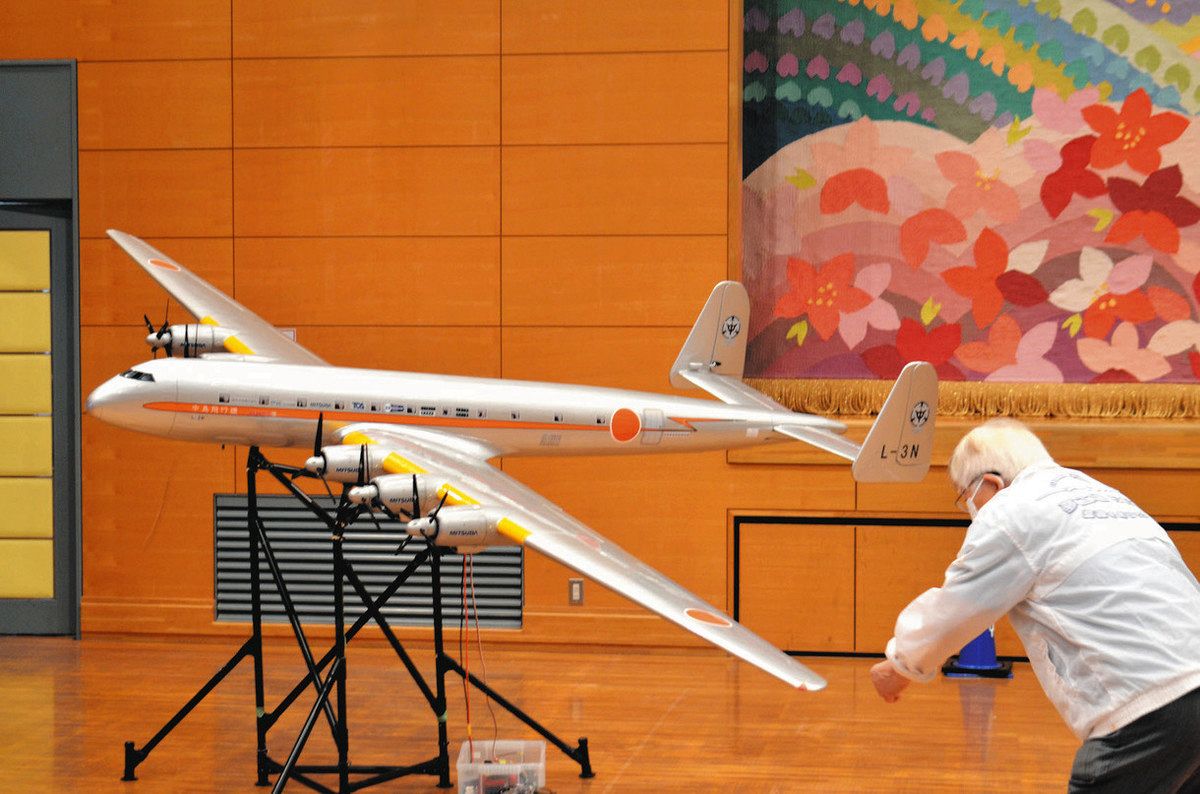
 www.tokyo-np.co.jp
www.tokyo-np.co.jp

å¹»ã®è¼¸éæ©ãå¯å¶½ã15åã®1ã¢ãã«ã11æã太ç°ãRCèªç©ºãã¼ã¸ã§ã³ããã§é£è¡ï¼æ±äº¬æ°è TOKYO Web
群馬ç太ç°å¸ã«ãã£ãä¸å³¶é£è¡æ©ï¼ç¾SUBARUï¼ãæ¦æä¸ã«è¨ç»ããä½ç¿¼6çºè¼¸éæ©ãå¯å¶½ï¼ãµãã/rt>ï¼ãã®15åã®1ã¹ã±ã¼ã«ã¢ãã«ã...
Attachments
blackkite
Don't laugh, don't cry, don't even curse, but.....
- Joined
- 31 May 2007
- Messages
- 8,299
- Reaction score
- 5,916
Attachments
blackkite
Don't laugh, don't cry, don't even curse, but.....
- Joined
- 31 May 2007
- Messages
- 8,299
- Reaction score
- 5,916
You can see Fugaku bomber version model rear camera movie and transport version model front camera movie.
View: https://www.youtube.com/watch?v=tudOa-Z9sMw
View: https://www.youtube.com/watch?v=9yshdxqllEw
Tonton-42
ACCESS: Secret
- Joined
- 10 May 2014
- Messages
- 259
- Reaction score
- 429
I don't understand why nr 3 and 4 engines have simple propellers on this model ... Is it the same thing on the real project ? (If a real project did exist ...)Hi! Transport variant model.

å¹»ã®è¼¸éæ©ãå¯å¶½ã15åã®1ã¢ãã«ã11æã太ç°ãRCèªç©ºãã¼ã¸ã§ã³ããã§é£è¡ï¼æ±äº¬æ°è TOKYO Web
群馬ç太ç°å¸ã«ãã£ãä¸å³¶é£è¡æ©ï¼ç¾SUBARUï¼ãæ¦æä¸ã«è¨ç»ããä½ç¿¼6çºè¼¸éæ©ãå¯å¶½ï¼ãµãã/rt>ï¼ãã®15åã®1ã¹ã±ã¼ã«ã¢ãã«ã...www.tokyo-np.co.jp
blackkite
Don't laugh, don't cry, don't even curse, but.....
- Joined
- 31 May 2007
- Messages
- 8,299
- Reaction score
- 5,916
Good question!!
Model shape is little strange compared with the original drawing. I don't know why.
I will ask your question to the Fugaku flying club.
Model shape is little strange compared with the original drawing. I don't know why.
I will ask your question to the Fugaku flying club.
Attachments
Last edited:
blackkite
Don't laugh, don't cry, don't even curse, but.....
- Joined
- 31 May 2007
- Messages
- 8,299
- Reaction score
- 5,916
The answer is as follows
"The six-engine transport aircraft 1/15 model in question was completed in 2016 and made its first flight.
There was an issue of what to do with the power when manufacturing this machine, but fortunately we were able to get a local company to prototype an electric double-reversing motor.
As you can see in the drawings, the original aircraft was planned to turn a four-wing constant-speed propeller with a diameter of 4.05 m with a 2600 horsepower engine, and it was not a double-inverted propeller, but we dared to try something new.
We have also confirmed that the flight with six prototype double-inverted motors mounted on the RC model.
The motor speed was lower than planned, and there was no room for thrust during flight.
The two central motors (No. 3 & No. 4) have been changed to normal commercial motors.
As a result, there are two types of propellers on the fuselage in the photo."
"The six-engine transport aircraft 1/15 model in question was completed in 2016 and made its first flight.
There was an issue of what to do with the power when manufacturing this machine, but fortunately we were able to get a local company to prototype an electric double-reversing motor.
As you can see in the drawings, the original aircraft was planned to turn a four-wing constant-speed propeller with a diameter of 4.05 m with a 2600 horsepower engine, and it was not a double-inverted propeller, but we dared to try something new.
We have also confirmed that the flight with six prototype double-inverted motors mounted on the RC model.
The motor speed was lower than planned, and there was no room for thrust during flight.
The two central motors (No. 3 & No. 4) have been changed to normal commercial motors.
As a result, there are two types of propellers on the fuselage in the photo."
Last edited:

